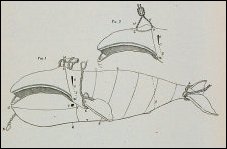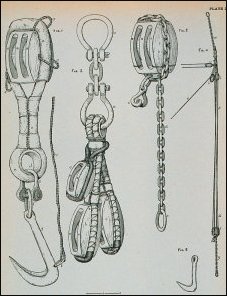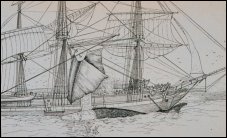| The Peterhead whaling trade |
|
Home |
Flensing Once the whale was dead it was secured to one of the boats by a rope passed around and through its tail. Then, the harpoons and attached lines had to be removed, often a difficult operation because the whales tended to float on their backs with the harpoons deep under water. The whale was towed back to the ship by all the boats roped together in a long line. To do this by rowing must have been a prodigious and exhausting task, although Scoresby notes that it was a cheerful operation performed with great expressions of joy. The whale having reached the ship it was taken to the larboard side and secured with the head towards the stern, ready for flensing, the removal of the blubber. For this a variety of knives and other implements were used. The rump, the tail end of the whale, was supported by a tackle and drawn forwards by a stout rope, the head being drawn in the opposite direction by means of the nose-tackle. In this way the body of the whale was forcibly extended. A band of blubber, 2 to 3 feet wide, lying between the fins and the head, was known as the kent and was used to turn the whale over. A system of powerful blocks and pulleys hanging from the head of the main mast was attached to the kent by means of a hook. The rope was then pulled tight by the ship's windlass, raising the whale in the water. The whale, lying belly up, extended and well secured was now ready for flensing. At this point the crew usually took a meal, and a dram, before the arduous labour began. The harpooners, their feet armed with primitive iron crampons to prevent them slipping, climbed down onto the belly of the whale. Under the direction of the specksioneer (the principal harpooner) they divided the blubber into oblong pieces or slips by means of a blubber-spade. A hook was then attached to the slip and drawn upwards, by means of a rope and capstan, progressively flaying the strip of blubber from the carcass. The slips, weighing up to a ton each, were winched on to the deck where they were cut up into one foot cubes. The blubber was then passed through the hatches into the hold and temporarily piled up. Once the belly had been flayed the whale was rotated onto its side by the kent tackle, and the upper surface stripped of fat. The lips were then removed exposing the whalebone (baleen) which was extracted in one mass. Once safely on deck the whalebone was split, with bone-wedges, into pieces containing 5-10 plates of baleen. Eventually once all of the blubber, including the kent, had been removed, the carcass, or kreng as it was known, was released, to sink or to become food for bears, sharks and birds. To strip a whale of 20-30 tons of blubber would have taken little more than three hours. Links |


